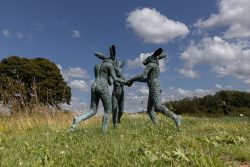 THE summer exhibition at Messums Wiltshire, in and around the ancient Tisbury tithe barn, features sculpture by gallery regular and invited artists, including Laurence Edwards and Sophie Ryder. Larger than Life runs to 30th September, and draws inspiration from the venue’s summer Festival of Dance.
THE summer exhibition at Messums Wiltshire, in and around the ancient Tisbury tithe barn, features sculpture by gallery regular and invited artists, including Laurence Edwards and Sophie Ryder. Larger than Life runs to 30th September, and draws inspiration from the venue’s summer Festival of Dance.
The challenge of this exhibition – particularly in the context of an exciting programme of contemporary dance – is the questions the works ask of visitors and onlookers, as we meet them on the common ground of shared space – what are you bringing to this relationship? How do you respond to this proposition? What is the effect of the body seated? standing? in motion? Do we feel more still or dynamic in relation to it?
Sean Henry poses these questions most economically in his use of scale. By making his three Standing Figures present and lifelike, but clearly larger than life, he creates encounters which invite the viewer to reflect on internal life.
Sophie Ryder’s Dancing Ladies – never exhibited before at this scale – are totally joyful, as anyone who saw her exhibition at the Halifax Piece Hall will know. They do inspire wonder, but over and above that, they make you smile and even want to join in the dance.
Her work is populated by hybrid creatures drawn from mythology and the natural world. Central to it is the pairing of the Minotaur, half-man, half-bull, and his female companion the Ladyhare. The artist says her intention is “to portray a joyful moment in time between three people. Probably subconsciously my two daughters and myself – kicking their legs and tipping their heads with carefree abandon.”
 Returning to Messums for the exhibition are Laurence Edwards’ Walking Men, whose earlier edition of five now stands overlooking Sydney Harbour at the Art Gallery of New South Wales. The figures include Shimmer and Hands On Hips. Whether in motion or contemplation, seemingly solid or in a process of transmutation in the case of Shimmer “from metal to gas, air, swarm, flock”, Edwards feels their presence speaks to a loss of control of an environment once mastered, and a search for a new meaning or identities to replace it.
Returning to Messums for the exhibition are Laurence Edwards’ Walking Men, whose earlier edition of five now stands overlooking Sydney Harbour at the Art Gallery of New South Wales. The figures include Shimmer and Hands On Hips. Whether in motion or contemplation, seemingly solid or in a process of transmutation in the case of Shimmer “from metal to gas, air, swarm, flock”, Edwards feels their presence speaks to a loss of control of an environment once mastered, and a search for a new meaning or identities to replace it.
Jason Mulligan draws on the ritualistic uses of carved stone, beginning with the prehistoric portable sculptures that functioned both as ornament and amulet. Pivot takes its cue from the contours of the wishbone, a lucky charm for the Etruscans and across the ages. The abstracted form, carved in Portuguese marble, echoes the twisting motion of the rotating pelvis as the body turns on one foot.
Late one night in London, Thomas Merrett saw two ghostly figures walking ahead of him, carrying long sticks. These sinister forms revealed themselves to be inspectors, prospecting for water leaks. This surprisingly low-tech task is best accomplished at dead of night, when the atmospherics of the city are dialled down, and their listening sticks, which amplify the gurgle and flow of water, can pick up the sound. This strangely old-fashioned task and its reliance on the faculty of hearing inspired Merrett’s Listener series, an encouragement to active listening, to use all of our senses in how we encounter and relate to the world.
 Alongside the exhibition there is a programme of contemporary choreography, workshops and films inside the barn.
Alongside the exhibition there is a programme of contemporary choreography, workshops and films inside the barn.
Pictured: Two of Laurence Edwards’ Walking Men, with part of the 13th century tithe barn in the background; Sophie Ryder’s Dancing Hares in the meadow; one of Helaine Blumenfield’s massive works on the lawns by the tithe barn.